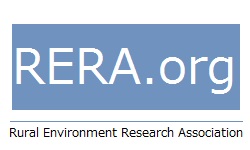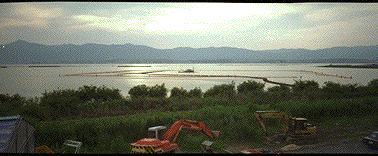|

English
/ Japanese / Chinese
Welcome
Hybrid
Lagoon System (“HLS”)
HLS's
Carrier and Reference
Our
Organization
Contact
|
Invitation
for the Integration Project for the Southern Lake Biwa Water
Quality Improvement.
For
the Southern Lake Biwa Water Quality Improvement by a Floating
Type Bio-reactor. -The direct purification of inland water
biological technology ( Ecological Succession )
Introduction
For
the purpose of improving the present water quality level of the
Lake Biwa, Shiga Prefecture has planned the integration project
for the Southern Lake Biwa, and announced the public invitation
for the project planned.
The
followings are taken up as measures to improve the eutrophic
Southern Lake Biwa environment;
To
reduce the loads that flow into the Southern Lake Biwa.
To
purify the Southern Lake water. The measures accurately being
taken up by Shiga Prefectural Goverment on the Southern Lake
Biwa water quality improvement are; 1) The efforts to requrate
nitrogen and phosphorous flowing into the lake, and to improve
the sewerage system, in connection with reduction in inflow
loads. 2) Various measures such as contact pebble oxidation
method, living filter methods, chemical treatment, aeration and
dredging are considered for the purification of the Southern
Lake Biwa. However, seasonal variation in functions, emplyment
of chemicals, securing of sludge disposing land space are
negative factor.
Direct
purification of inland water by biological technology
(Ecological Succession). This idea constituting the care of the
Integration Project for Southern Lake Biwa Water Quality
Improvement is a method to directly purify inland water by
biological technology (Ecoligical succession), which is
intended for biological treatment of sludge (back sapropel)
depositted on the bottom of the Southern Lake Biwa and floating
sludge in suspension. The idea is also intending to purify
bottom pollution in the Southern Lake Biwa without using any
chemicals and improve and restore the self purification power
of the lake. Moreover, for topographic preservation of the
bottom layer, the polluted sands are dredged area for the
restoration of natural topography as well as it is used for
reclamation of the bottom layer. Eutrophication substances such
as nitrogen and phosphorous are utilized as a soil improver.
Formation
of sludge (black sapropel) and its influences, and
countermeasures (Dredging & Sand covering) ; A bacteria
socondarily produced in an eutrophic inland water will be killed
and deposited into bottom of inland water. The sludge deposit
thus formed contains a large quantity of eutrophication
substances such as nitrogen and phosphorous, and is no
transillumination and chemically stable, or no oxidation and no
reduction, moreover, re-elude eutrophication substances and
aggravates the quality of inland water. Recently, it is
increasingly important to note the relation between the bottom
layer condition and the water quality, and the dredging method
for direct purification of the eutrophic sludge deposit and the
sand covering method to cover the sludge deposits with sand for
preventing eutrophication substances re-eluding from the sludge
deposit are adopted. There still remains, however, some
technical problems to be solved in those methods as dredging the
sludge;
The
lack of sludge disposing places. It is very difficult to secure
place where a large quantity of sludge is disposable, because
of the septic odor of the sludge (black sapropel).
Chemicals
treatment of sludge requires.
The
transportation of sludge requires much expenses and energy.
Dredging
methods which is accompanied by the transfer of sludge does not
always results in the environmental purification because of the
suspended sludge which remaining in the dredged area.
Dredging
method may damage the topography, and produce an unnatural one
destroying the ecosystem and aggravating water quality.
Besides,
sand covering method requires a large quantity of sand, and there
are other technical problems to be solved, that is, an unnatural
topography, and produce an unnatu.
Concept
The
basic concept of this project is to purify estimated 5 million m
of sludge (black sapropel) and 20 million m of bottom pollution
deposited at the bottom of the Southern Lake Biwa to cover up the
bottom layer with the purified sludge, which will prevent
eutrophication substances (Nitrogen, Phosphorous) to elute from
the bottom layer. Farthermore, the dredged area is backfilled
with the purified sludge so that the ecosystem and the topography
in the Southern Lake Biwa may be improved and the natural
purification power of the lake is restored.
Thus the
"Integrated Water Quality Improvement Project" is
aiming at simultaneous accomplishments of both purification of
pollutant and the restoration of natural purification power of
the Suthern Lake Biwa.
This
Integration Project for Southern Lake Biwa Water Quality
Improvement is jointly proposed by the consortium EST Group,
organized by nine corporations.
Integration
Project for Southern Lake Biwa Water Quality Improvement by a
Floating Type Bio-reactor.
Outline
This project
outline is to propose the integration project for the Southern
lake Biwa water quality improvement, having the following
features;
To
purify simultaneously both of estimated 5,000,000m sludge (black
sapropel) and bottom pollution of the Southern Lake Biwa by a
floating type bio-reactor.
To
purify water quality by biological succession technology, no
chemicals being used.
Sludge
at the bottom of the lake is dredged for the improvement by
biological treatment (200days/year x 10years), and the bottom
layer dredged is covered up with treated sludge for the
improvement of bottom layer.
To
recover ecosystem of the lake bottom so that the water quality
is improved by the natural purification power restored.
To
allow the bottom sediment (sludge and black sapropel) to be
odorless and be reduced in volume by the succession technology
for its utilization.
This
project requires neither the piping for sludge transfer nor the
final disposal land space.
The
theoretical denitrification capability of the floating type
bio-reactor (T-N 6,250 kg/day) reaches 52 % of T-N 12,000
kg/day, the estimated total nitrogen quantity flowing into Lake
Biwa.
This
project is proposed by the consortium EST Group, which is
organized by RERA
Environmental
Engineering Consultant, RERA, and the Agricultural Environment
Study Committee. To: Manager, Living Environment Dept., Shiga
Prefecture. "Integration project for the Southern Lake Biwa
Water Quality Improvement"- Direct purification of inland
water by a floating type bio-reactor.
Contents
Introduction.
On
the Integration Project for Southern Lake Biwa Water Quality
Improvement.
Chapter
1.
The outline of the integration Project for Southern Lake
Biwa Water QualityImprovement by a Floating Type Bio-reactor.
Chapter 2.
The outline of the facilities (Main facilities)
1.
Purofication processes (Dredging, Pretreatment, Purification
installation, etc.)
2. Floating type facilities (Hull and
Equipment)
3. Operation control conditions (Maintenance).
4.
Patents and Concession.
Chapter 3.
Specifications of the facilities.(Floating facility, (1) hull
(2) loading installations) Specifications of main equipment.
(Performance, capacity, design loads, materials, quantity)
Chapter 4.
Pilot operation plan (Purpose, design, expediture, etc.)
Chapter 5.
Estimated opration cost. Construction of facilities,
maintenance & management of the facilities and pilot
operation.
Chapter 6.
Summary (Business principle, operational efficiency,
etc.)Drawings (A-1 size ) Arrangement drawing, cross sectional
view of equipment, flowsheets.
The
Reference (1);
Biological technology "Ecological
Succession" for direct purification of inland water.
1.
Basic conception to improve the eutrophication of Furukaw marsh
of Rikuzen-Takada City, Iwate Pref.
2. Report on sludge (black
sapropel) succession tests entrusted by Rikuzen-Takada City.
3.
Lecture on sludge (black sapropel) succession test, by Mr.
Hiroshi Kishi, Agricultural Environment Study Committee.
4.
Lecture on sludge (black sapropel) succession test, by Mr.
Michiyoshi Kouno, Furukawa marsh Conservation Society.
5.
Technological Notes.
- "Low-loads semi batch type,
activated sludge process" RERA.
- "Denitrification
reaction theory of bacteria". RERA.
Reference
(2);
Floating type facilities.
2-1. Plant
hull.
1. Structure of hull.
2. Study for hull fitting
processes.
3. Study for the supporting vessel and towing
work.
4. Mooring (external force, wind speed, wave height,
lake water flow, anchor, piles, etc.)
5. Counterplan for
corrosion (coating & countermeasure for electrocorrosion).
2-2. Study
on the concrete barge.
References
(3);
Sludge (black sapropel) dredging.
References
(4);
Method of scattering improved sludge into lake bottom.
References
(5);
Dewater equipment.
References
(6);
Examples on the environmental assessment.
Information:
Jointly proposed corporations for the public subscription.
|

